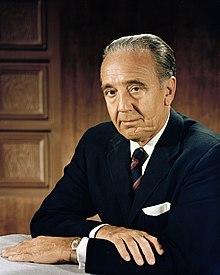Kurt Heinrich Debus
Kurt Heinrich Debus (born November 29, 1908 in Frankfurt am Main , † October 10, 1983 in Cocoa Beach , Florida ) was a German rocket pioneer . From 1944 to February 1945 he was operations manager of test stand VII in Peenemünde , and between July 1962 and November 1974 he was director of the Kennedy Space Center .
biography
Kurt Debus began studying electrical engineering at the Technical University of Darmstadt in 1929 , where he became a member of the Markomannia fraternity in 1930 - later Darmstadt's Rheno-Markomannia fraternity . From 1933 to 1936 he was a member of the SA , from the beginning of 1939 he was a member of the SS (membership number 426,559). In 1935 he obtained his diploma in electrical engineering and became Ernst Hueter's assistant . In 1939 he received his doctorate in electrical engineering at the TH Darmstadt and then continued to work as a research assistant at the TH. While he was still working at the TH Darmstadt in 1942, he reported a work colleague to the Gestapo for alleged “anti-state” statements. He was then sentenced to two years in prison under the treachery law of the time .
From 1939 onwards, Wernher von Braun had tried several times without success to win Debus over to work on the V2 in Peenemünde. Given the choice between becoming a soldier or going to Peenemünde, he decided on the latter and from August 1943 worked as a development engineer at the Peenemünde Army Research Institute on the V2 rocket . Most recently he was operations manager of test stand VII .

Debus came to the USA in 1945 together with a group of engineers and scientists led by Wernher von Braun as part of Operation Paperclip . The group worked in Fort Bliss, Texas for five years until 1950 and then moved to the Redstone Arsenal in Huntsville, Alabama .
From 1952 to 1960 Kurt Debus was with the Army Ballistic Missile Agency (ABMA), which was located on the premises of the Redstone Arsenal . For this facility, he supervised the launch of the first US ballistic missile , the military version of the Redstone, at Cape Canaveral Air Force Station . The Mercury Redstone program, a forerunner of the Apollo program, emerged from the military redstone program with his significant involvement .
Debus became director of the Launch Operation Center in 1962 and eventually director of the John F. Kennedy Space Center . During this time he was responsible for the start of the Apollo program including the six moon landings ( Apollo 11 to Apollo 17 ; Apollo 13 was canceled prematurely). The following missions were carried out under his leadership:
- 1961: Alan Shepard , first American in space
- 1962: John Glenn , the first American to circumnavigate the world
- 1969: Neil Armstrong becomes the first person on the moon
- 1973: Start of the Skylab space laboratory
In 1974 he retired from the position of Director of the Space Center. From 1975 to 1980 he was chairman of the supervisory board of OTRAG .
Honors
In 1975 he was elected a member of the National Academy of Engineering . The lunar crater Debus on the back of the moon was named after Kurt H. Debus .
source
- For his 70th birthday: Contribution Mannheimer Morgen , November 29, 1978
Individual evidence
- ^ A b Rainer Eisfeld : Moonstruck. Wernher von Braun and the birth of space travel from the spirit of barbarism. zu Klampen, Springe 2012, ISBN 978-3-86674-167-6 , p. 97.
- ^ Members Directory: Dr. Kurt H. Debus. National Academy of Engineering, accessed June 8, 2017 .
literature
- Space , No. 4/2020, p. 49
Web links
- Biography Dr. Kurt H. Debus of NASA's Kennedy Space Center , 1987, English
- Cheryl L. Mansfield (NASA's John F. Kennedy Space Center): Dr. Kurt H. Debus: The Father of Kennedy Space Center , June 28, 2007, online (English)
- C. McClesky and D. Christensen: Dr. Kurt H. Debus: Launching a Vision. 52nd International Astronautical Congress, Toulouse (France), 2001, online (English; PDF; 3.2 MB)
- Christopher C. Kraft jr .: Kurt H. Debus, 1908–1983 , online
- Biography at raumfahrtkalender.de
- Kurt Heinrich Debus in the online archive of the Austrian Media Library
| personal data | |
|---|---|
| SURNAME | Debus, Kurt Heinrich |
| BRIEF DESCRIPTION | German-American director of the Kennedy Space Center |
| DATE OF BIRTH | November 29, 1908 |
| PLACE OF BIRTH | Frankfurt am Main |
| DATE OF DEATH | October 10, 1983 |
| Place of death | Cocoa Beach , Florida, USA |
